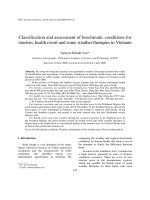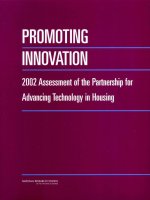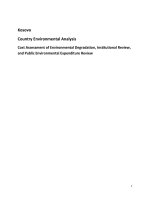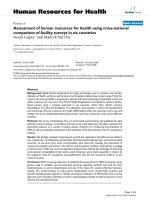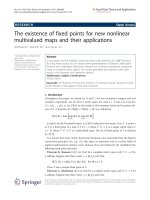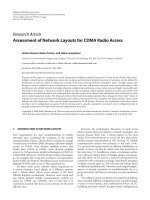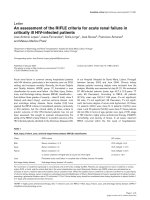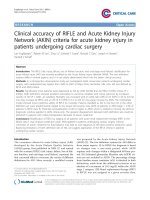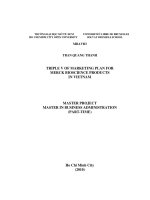ASSESSMENT OF ENVIRONMENTAL CRITERIA FOR NEW COUNTRYSIDE APPLIED IN MINH KHAI COMMUNE – HOAI DUC DISTRICT – HANOI
Bạn đang xem bản rút gọn của tài liệu. Xem và tải ngay bản đầy đủ của tài liệu tại đây (1.26 MB, 29 trang )
UNDERGRADUATE THESIS
ASSESSMENT OF ENVIRONMENTAL CRITERIA FOR NEW
COUNTRYSIDE APPLIED IN MINH KHAI COMMUNE – HOAI DUC
DISTRICT – HANOI
Supervisor: Ass.Prof. Nguyen Dinh Hoe
Student: Hoang Thi Giang
Outlines
I. INTRODUCTION
•
•
•
In 2008, the Party has adopted the Resolution 26 on agriculture, farmers and countryside,
piloting new models in 11 rural communes with the aim of testing methods, mechanisms
and policies related to new countryside
National Targeted Program on new rural construction in the period 2010-2020
Minh Khai commune has implemented the program from 2010
II. OVERVIEW OF NEW RURAL COMMUNES AND THE NATIONAL TARGETED PROGRAM ON
BUILDING NEW COUNTRYSIDE
1. New countryside
•
A rural commune is a third-level (commune-level) administrative subdivision of Vietnam. Rural
communes are subdivisions of counties, which are in turn subdivisions of provinces
•
New Rural period 2010 - 2020 has differences from Rural:
- Economy is developed, material and spiritual lives of people are enhanced
- Rural areas are developed under planning
- People’s cultural standard is enhanced
- Security is good
- Quality of the political system is improved
2. The objectives of National Target Program on Building New Rural Communes
To build a new countryside with gradually modern socio-economic infrastructure, rational
economic structure and forms of production organization;
To associate agriculture with quick development of industries and services, and rural with
urban development under planning
To assure a democratic and stable rural community
To protect the eco-environment and maintain security
To raise people’s material and spiritual lives
3. The criteria for New National Rural
•
•
⁻
⁻
⁻
⁻
⁻
19 criteria
Environment
The percentage of households using clean water in accordance with national
standards
The production facilities reaching environmental standards
No activities causing environmental degradation and having activities to develop
green, clean and beautiful environment
Cemetery is constructed as planned
Waste, waste water is collected and handled as prescribed
III. General socio – economic conditions of Minh Khai commune
1. Natural conditions
Land resource
• The total area of the commune is: 192.25 ha, of which
⁻ 114.03 ha of agricultural land, including 111.87 ha for annual crops land, 1.93 ha
⁻
⁻
for perennial plantings, 1.92 ha for aquaculture land. Annual crop land including:
53.8 hectares of paddy land, 56.38 ha of others.
Non-agricultural land is 78.22 ha, 38.3 ha of which for housing land, 31.61
hectares of exclusively used land, 0.83 hectares of land for beliefs, 0.97 ha of
cemetery land, 6.16 ha of rivers land and water surface; other non-agricultural
land is of 0.35 ha.
The type of soil in the commune is the mixture of light rich soil and sandy soil
which is suitable to cultivate fresh vegetable, ornamental plants and fruit trees.
Water resource
•
•
Surface water sources: ponds
The groundwater resources are plentiful, with over 8 meters in depth.
Groundwater quality is generally pretty good but has high content of iron.
2. Economic conditions
i.
Agricultural sector
•. Increase crop productivity, but decrease proportion in economy
•. Crops: mainly are rice, corn, sweet potatoes and some others.
•. Livestock: pig, cow and chicken.
ii. Industrial sector
•
•
Construction and small scale – industries have thrived
•
•
This sector attracts the most proportion of workers
The handicraft products include: candy and biscuit, cassava, sorghum, dried
noodles and some others.
Production facilities locate are small-scale and locate in the neighborhood
iii. Service sector
•
•
•
The value of production in 2010 reached 36.0 billion, accounting for 18.1% of the
total production value of the whole commune.
In 2010 the commune had 550 employees participating in trading, accounting for
18.33% of the entire labor force.
This sector has not been commesurate with the potential
3. Social status
•
Total population of the commune is: 5642 persons, 1355 households, an avarage
of 4.2 persons/household.
+ Population growth rate:
+ The rate of natural increase:
•
•
+ Mechanic growth rate:
2%
1,89%.
0,11%
99.5% of population is “Kinh“ and 0.5% is other ethnic groups.
Labor: 3208 workers, accounting for 56.8% of the population. Agricultural
workers accounts for 463 people (15.8%). Commercial services account for the
lower 462 people (14.2%). Industry - Handicraft Industry – Construction
combined account for a high proportion of 2123 people (70%)
General assessment of the socio – economic – natural conditions and environment related to the construction of new countryside
Advantages
•
Locating near the capital Hanoi brings to the commune number of advantages, especially on trade
exchange.
•
•
Alluvial source from Day river
The economy has been shifting in the right direction, increasing the proportion of industry and services,
and reducing the proportion of agriculture.
•
Culture, health, education ... are gradually invested in facilities, equipment, people which to ensure
responsive and better serve the needs of the people and the development of the commune.
•
The commune’s labourers have skills and experinces from years of working.
•
•
•
•
Disadvantages
Under the effect of industrialization and urbanization; less people interests in
agriculture leading to poor investment in technology, capital, and infrastructure
Socio – Economic infrastructures have not met the requirements of the new
development in the context of industrialization, urbanization taking place at high
speed.
The complexity of international markets and the global economic downturn has
caused a negative impact on the process of commune’s socio – economic
development.
The policies applied in the commune are not synchronized.
IV. Research method
Use the research methodology to evaluate the
performance of five environmental criteria of New Countryside programs in Minh
Khai commune
Research’s questions
•
•
•
From the beginning of the new countryside program, which criteria has the
commune done?
What ways and measures the commune has been used to achieve these criteria?
For those criteria that are not achieved, what is the reasons? What are the
difficulties and challenges in the implementation process?
1. Methods of collecting data
i. Collecting secondary data
Data are collected from the articles, reports and statistics from the commune
ii. Interview
The interview’s subjects: the producers; households not involved in the
production
iii. Survey, direct observation
Direct observation in the study area is in order to verify and detect additional
environmental problems.
2. Method of document analysis:
•Based on data collected to analyze and synthesize to make charts,
diagrams and answer the questions of the research.
•It is needed to be careful when select the information to use in
building accurate theoretical points of the research.
V. Results
Criteria
The percentage of households using clean
2012
Not Achieved
water
The production facilities reaching
2013
Achieved
100% of populations uses clean water
Not Achieved
Not Achieved
Not Achieved
Not Achieved
Having a planned cemetery
Not Achieved
Not Achieved
Waste and waste water are collected and
Not Achieved
Not Achieved
handled
(Just collect solid waste)
(no waste treatment area)
environmental standards
No activities causing environmental
degradation; having activities to develop a
green-clean-beautiful environment
1. Criterion “Number of households using clean water”
•
•
Rain water and water from drilled wells are main water resources for daily
activities
Water from drilled wells is used for activities such as: washing or production
after being filtered through a filter tank to eliminate iron content before using
Rainwater is used for cooking
2. Criterion “The production facilities reaching environmental standards”
•
•
•
•
•
800 households engaged in manufacturing
Most of the production facilities are small scale; production facilities located in
the residential area
The laborers are not trained about labor safety and food safety.
People pays attention on profit more than on the food hygiene
The commune has no professors on food safety.
3. Criterion “No activities causing environmental degradation and having activities to
keep green – clean – beautiful environment”
i.
•.
•.
From agriculture
Flowering requires a lot of chemicals
Number of farmers renting their land to flowersares from other communes
(Tay Tuu commune) increases
According to the statistics show that from 2001 to 2011, the area of cultivation
of other annual crops (including floriculture) increased 16:38 ha.
ii. From productive activities
•
•
Old technology
Economic benefits
4. Criterion “The cemetery area was built as planned”
•
•
•
•
A 0.97 hectares cemetery
Having a watchman and communal rules
Having a plan to rearrange the cemetery
It’s still on planning
5. Criterion “Waste and wastewater is collected and processed”
•
•
•
•
Collection teams to collect waste regularly
Sewer system has been concreted but not completed
Overload in high season of production
No treatment area for waste and wastewater
